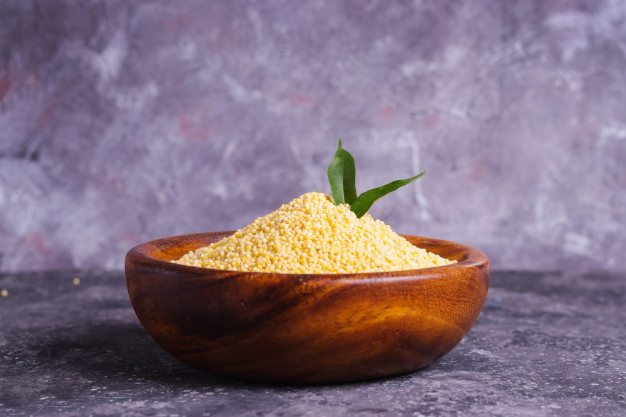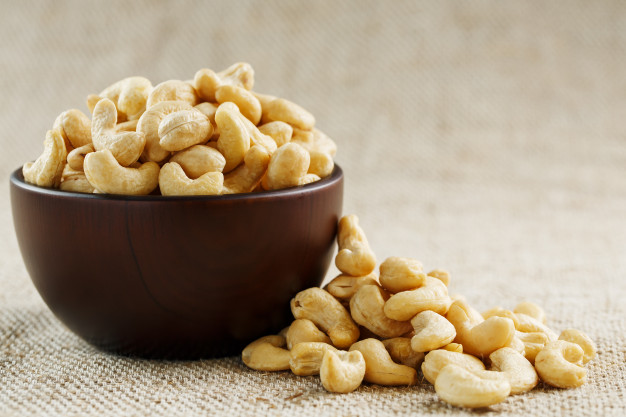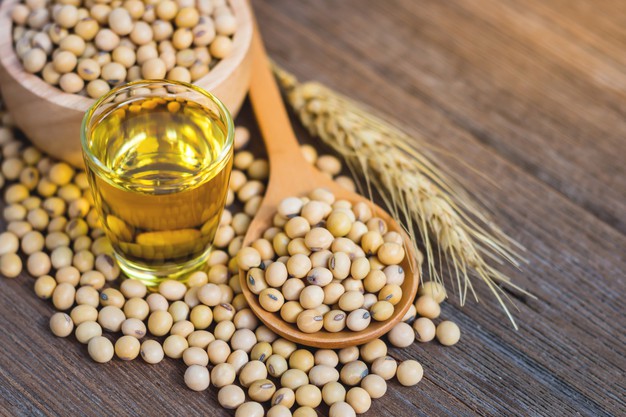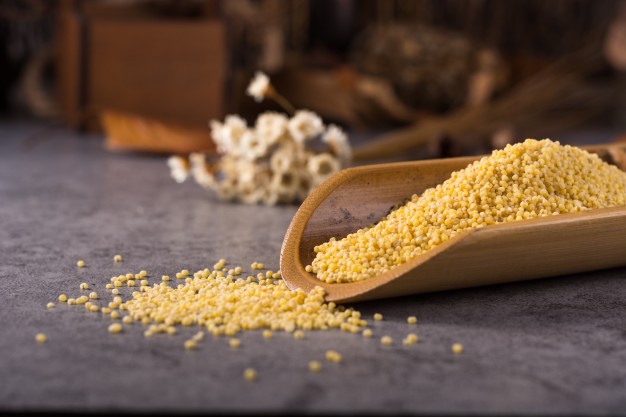Foxtail millet, also known as Setaria italic, Italian millet, Chinese Millet, Hey millet, German Millet, Red Rala, Giant Setaria Hungarian Millet. It is an important and nutrient dense millet belongs to Poaceae family. It has been widely used for various therapeutic purposes.
Characteristics
- Foxtail millets are small and oval shaped seeds
- They are yellow in colour
- It has seen that the head of the seed of this millet is looked like the bushy tail of the fox hence the name of the millet is coined as foxtail millet
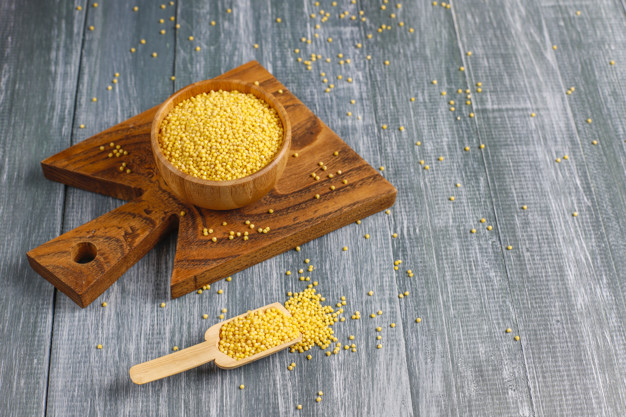
Nutritional profile
- It contains desirable amount of carbohydrates and dietary fibres
- It contains lesser amounts of fat as well
- It contains significant amount of proteins and contains various essential amino acids
- It also contains several micro nutrients and especially rich in B vitamins, iron, calcium and phosphorus
Health benefits
Role on immunity
- Its vitamins and minerals components are considered as the vital components that help to boost up the overall immunity
- It also helps to promote early recovery from any kind of illness

Role on nervous system
- Its B vitamin components (especially Vitamin B1 and Vitamin B6) play significant role in improving the growth and functionality of nervous system
- Its protein contents also play vital role in transmitting nerve signals thus help to manage the nervous system especially central nervous system
- It helps to protect the neurons from oxidative damages thus reduces the prevalence of neurological disorders
- Its iron content is also associated with improving brain activity as it helps to promote the supply of oxygen to brain cells
- It helps to improve cognition as well as memory
- It has seen that it significantly reduces the prevalence of Alzheimer’s disease, Parkinson’s disease, dementia, multiple sclerosis and Bel’s Palsy
Role on digestive health
- Consumption of foxtail millet is a great option for avoiding digestive issues
- Its high fibre content is responsible for increasing bowel movement hence helps to prevent constipation
- It also helps to promote the gut health by stimulating the growth of intestinal beneficial microbes
- It can be easily consumed by individual with celiac disease as it is absolutely gluten free
Role on weight management
- Foxtail millet is considered as an imperative weight reducing food and it should be consumed by obes individual
- It has seen that the digestion of foxtail millet occurs at a slower rate, which is responsible for providing a feeling of stomach fullness thus decreases the craving for food that ultimately reduces calorie consumption
- Its fibre content is also responsible for preventing obesity. Fibre found in foxtail millets helps to reduce the concentration of cholesterol in body thus its consumption is very useful for reducing body fat percentage and visceral fat. On the other hand its fibre content is also associated with reducing appetite by keeping an individual full for a long period of time thus decreases food consumption, which positively stimulates weight reduction
- Tryptophan present in foxtail millet also plays significant role in weight reduction as it helps to trim the appetite and also accountable for tightening the belly

Role on skeletal system
- It is considered as a good source of calcium thus its consumption is really very helpful for promoting the growth and development of bones
- It helps to improve bone mineral density and strength
- It is better to consume foxtail millet for reducing the prevalence of bone disorders or fractures
Role on muscle
- It contains significant amount of iron as well as proteins, which are essentially required by the body for maintaining proper health and functionality of muscle
- Its Vitamin B1 content helps to synthesize acetylcholine (neurotransmitter), which is associated with transmitting messages between nerves and muscles thus promotes neuromuscular activities
- It helps to increase muscle mass as well
- It helps to maintain muscle elasticity too
- Its iron component is responsible for transporting sufficient oxygen to the muscle, which helps in muscle contraction
- Its consumption is extremely useful for preventing muscle weakness

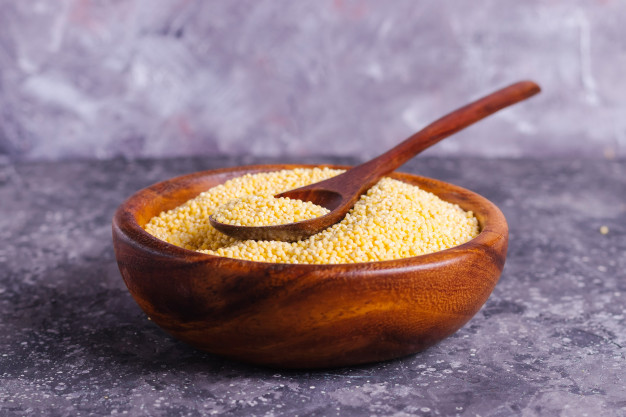
Role on skin
- Protein contents of foxtail millets help to support and strengthen the skin tissues thus improve skin health
- The amino acids present in foxtail millets help to stimulate the synthesis of collagen, which help to improve skin elasticity
- It also helps in skin revitalization thus its consumption is very effective for providing a youthful and healthy skin
- It helps to prevent ageing as well
- It also helps to decrease the prevalence of wrinkle and dark spots
Role on hair
- It helps to promote hair growth
- It helps to strengthen the hair and significantly reduces hair falls
Medicinal uses
It has been extensively used for centuries for treating various diseases, which include –
Restless legs syndrome
- It is an abnormal health condition characterized by an uncontrollable urge to move the legs and it is mainly caused by iron deficiency
- Consumption of foxtail millet is very beneficial for preventing this disorder as it provides significant amount of irons

Cardiovascular diseases
- Its fibre content plays significant role in promoting cardiac health
- Its lipid lowering activity is responsible for inhibiting plaque formation within blood vessels thus decreases the prevalence of atherosclerosis and coronary artery disease
- Its Vitamin B1 content also helps to protect the heart
- It helps to prevent hypertension as well
Diabetes mellitus
- Consumption of foxtail millet is incredibly helpful for decreasing blood sugar concentration
- Its fibre content is considered as the main component that helps to reduce the concentration of sugar in blood as it helps to decrease the rate of glucose absorption from intestine
- Individuals with fluctuating blood sugar level should include foxtail millet in their diet as it helps to stabilize blood sugar level
Hypercholesterolemia
- Fibre present in foxtail millet is responsible for decreasing the level of LDL, VLDL and triglyceride in body whereas helps to increase the concentration of HDL thus its consumption is very effective for maintaining a healthy lipid profile
Traditional uses
- It has been used by China as an astringent agent
-
 India has widely used foxtail millet as an imperative diuretic substance
India has widely used foxtail millet as an imperative diuretic substance - In India it has also used for centuries for treating bone fractures
- In Pakistan, it has been extensively used for enhancing libido
- It has been used for treating cholera as well as fever
- It has been also used as a remedial action for diarrhoea
- It has seen that in Western Himalaya it is used by combining with cow’s curd for treating measles
General consideration of using foxtail millet
- It can be used for preparing sweet as well as savory foods
- The grain can be cooked with water or milk
- Foxtail millet seed can be grounded to produce flour, which can be further utilized for preparing porridges or breads or cakes or puddings
- It can also used for preparing noodles
- It can be used for preparing vinegar and alcohol
- Sprouted foxtail millet can also be consumed as vegetables
Risk factors
- It should be consumed as per recommendation otherwise it may develop various gastrointestinal disorders
- Sensitive people may develop allergic reaction from this millet thus it is better for them to avoid its consumption
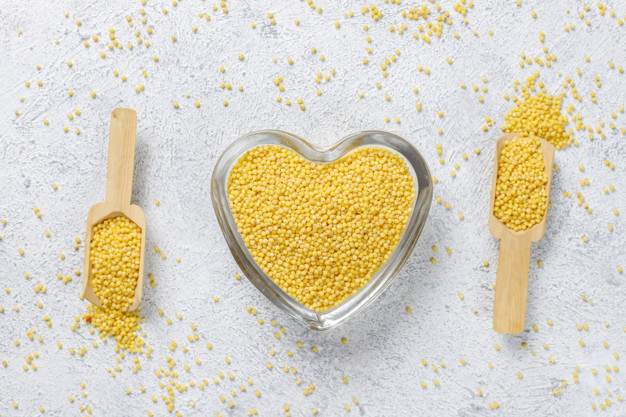
Source:
Anusha, B., Hymavathi, T.V., Vijayalakshmi, V., Reddy, P. and Robert, T.P., 2018. Lipid-lowering effects of foxtail millet (Setariaitalica) and quinoa (Chenopodium quinoawild) in pre-diabetics. Journal of Pharmaceutical Research International, pp.1-7.
Hou, D., Chen, J., Ren, X., Wang, C., Diao, X., Hu, X., Zhang, Y. and Shen, Q., 2018. A whole foxtail millet diet reduces blood pressure in subjects with mild hypertension. Journal of cereal science, 84, pp.13-19.
Narayanan, J., Sanjeevi, V., Rohini, U., Trueman, P. and Viswanathan, V., 2016. Postprandial glycaemic response of foxtail millet dosa in comparison to a rice dosa in patients with type 2 diabetes. The Indian journal of medical research, 144(5), p.712.
Ren, X., Yin, R., Hou, D., Xue, Y., Zhang, M., Diao, X., Zhang, Y., Wu, J., Hu, J., Hu, X. and Shen, Q., 2018. The glucose-lowering effect of foxtail millet in subjects with impaired glucose tolerance: A self-controlled clinical trial. Nutrients, 10(10), p.1509.
Sachdev, N., Goomer, S. and Singh, L.R., 2021. Foxtail millet: a potential crop to meet future demand scenario for alternative sustainable protein. Journal of the Science of Food and Agriculture, 101(3), pp.831-842.
Sharma, N. and Niranjan, K., 2018. Foxtail millet: Properties, processing, health benefits, and uses. Food reviews international, 34(4), pp.329-363.
